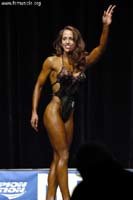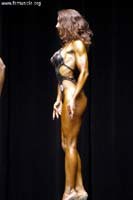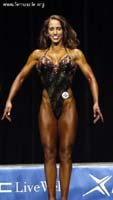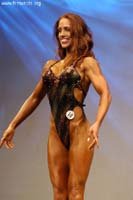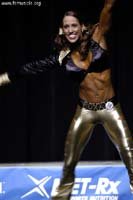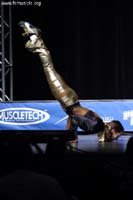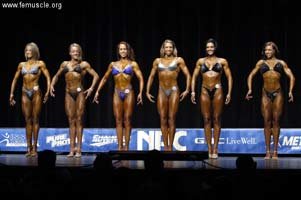Many competitors are gung-ho when it comes to pre-contest preparation, but enter the off-season, and some slack on training, nutrition, or just fail to map out a plan until it's time to diet down for that next show. I know what you might be thinking, because I used to think this myself.
This is my time to be 'normal' again."
It seems like a logical reason to become lax in your training and a little more lenient in your nutrition, but in reality, all this does is wastes precious time. You have the greatest chance of making your best progress in your off-season, before it's time to get ready for the next show.
In this article, I will cover the importance of a fine-tuned off-season program. I will teach you how to customize your program to your goals, lifestyle, and how to get the most out of your hard work. If you're serious about moving to the next level, you need to act serious 100% of the time, not just for those 12 weeks out of the year leading up to the show.
Step 1: Getting Judges' Feedback
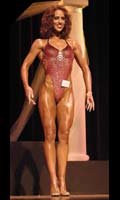 The first step in a productive off-season starts before your show day ends. Yes, it begins with getting tangible feedback from the judges. You probably won't want to stick around. Everyone is dead tired on show day, and you have to wait till all the awards are given out just to spend 5 minutes talking to a judge. Well, it's most definitely worth it.
The first step in a productive off-season starts before your show day ends. Yes, it begins with getting tangible feedback from the judges. You probably won't want to stick around. Everyone is dead tired on show day, and you have to wait till all the awards are given out just to spend 5 minutes talking to a judge. Well, it's most definitely worth it.
There have been times when I stayed for feedback, and times when I left with none, and I have to say that all the feedback I've ever received has helped me to grow and develop into a better competitor every single time I step onstage.
Talk to 2-3 judges at the end of the show about what you can improve upon. Ask as many questions as you need to get a good understanding of your strengths and weaknesses. Be polite, thank the judge for his/her time, and move on.
Don't get offended by what they tell you. You are, after all, coming to them and asking them for criticism. This is what you want. This will help you become stronger and more competitive the next time you step on stage.
Step 2: Get In The Right Mindset
Most female competitors I know have the same problem when they enter the off-season. They freak out about every pound of fat they regain! While it's important to remain relatively lean in the off-season, it's not good physically or mentally to remain at low body fat levels for continuous periods of time. In addition, your mindset needs to change from losing fat to putting on lean muscle and improving your weak body parts.
You cannot do this effectively if you are adding in a ton of extra cardio so you don't "blow up," or you are restraining your calories so you don't gain that 1 extra pound! In the same sense, you don't want to let yourself go completely and gain 25 lbs., do no cardio, and have cheat meals every day.
Change your mentality so you are focused on lean muscle gain, and maintaining your body fat about 15 lbs. over contest weight. If your weight creeps up, let it. Everyone has a set point of body fat that their body will fight to get to. Remember that your goal and number one priority here is to make lean muscle gains. Eat clean, train hard, but forget about the fat loss!
Step 3: Formulate A Training Program
This should begin a day or two after your competition. There are many things to consider before you start listing training splits and exercises. Think about how much time you can realistically devote to training. Consider the judges' feedback and devise a split that will address your weak points, while still allowing adequate rest for recovery and growth.
Know how long you have until it's time to begin dieting again for your next competition. Get your hands on all the research material you can in regards to training and nutrition. This step is very important, even if you are working with a trainer. Educating yourself is the only way you can grow as a competitor and get to know your body.
Blindly following a plan set out by a trainer might get you the physique you want, but you still won't know any more than you did before you began competing. Question, research, educate. This is a big step in setting you apart from the competition.
Setting Goals
Once you've done the above, make a timeline and set mini-goals for yourself. Planning out your strategy a year in advance is a great idea, and not unheard of.
If you have a 6 month off-season, you can divide your training into 6-8 week periods. Review and assess at the end of each period, and make any necessary changes.
For instance, my recent off-season was focused on improving my back thickness and width. I prioritized back by training it on day one, added in new and more effective exercises, changed my rep scheme slightly, and put in an extra second day later in the week.
After 6 weeks, I reviewed my training logs and assessed my progress, making any necessary changes to keep improving, or to focus on another mini-goal.
Tracking your total volume is an important step in your program's effectiveness. Keep tabs on the total number of sets you train for each body part. Typically a normal volume workout would be 12-15 sets for large body parts, while a higher volume would be 18-22 sets. For smaller body parts, the volume can be significantly less, with 8-10 sets.
Cardio
As for cardio, I usually recommend cutting back to half of what you normally do during contest prep. I rarely do any cardio when prepping for a show, so I might do it once a week in the off-season.
Since I compete in fitness as well as figure, I count 1-2 routine practices per week as my cardio. I recommend no more than 4 sessions per week of 30-45 minutes.
Training Key Points
- Higher body fat and increased calories equal increased metabolism.
- Increased calories equals increased strength and recovery rate.
- Consider increasing your overall training volume.
- Consider training your weak part(s) twice per week.
- Don't train more than 3 body parts per workout, so you can give enough attention to each individual muscle group.
- Keep cardio to a minimum to maintain about 15 lbs. over contest weight.
- Track total training volume and increase or decrease workload based on recovery rate, energy and strength levels, and individual body part goals.
- Change your program up for variety, but keep it consistent long enough to yield solid gains.
Step 4: Planning Your Diet
Yes, it's still considered a diet, even if your goal is not fat loss. Proper nutrition is the number one way you can change the effectiveness of your training program and thus, the results you'll yield from that program.
To maintain a lean body fat and still make gains, your calories only need to be 200-300 more than they were while you were dieting.
I like to manipulate my carbohydrates primarily, and add in some dietary fats as well. My numbers change from being 150g protein/100g carbs/25g fat during the season to 150g protein/150g carbs/35g fat during the off-season. You may need to try several different plans to see what feels the best for you. Considering cheat meals is another big factor.
If you rarely cheat, you will be able to consume more calories from clean foods and still stay lean. I recommend cheating no more than 1-2 times per week, and not going crazy on those cheats. By not going crazy, I mean eating 3-4 slices of pizza instead of 8 plus breadsticks!
I highly recommend keeping alcohol limited or eliminated. It will drain your body of the nutrients it needs for muscle repair and growth. Don't waste your off-season by partying all the time. You might be training hard, but without the nutrition backing it up, you won't see your best gains—period!
Protein and Carbohydrate Types and Timing
I want to briefly address this very important aspect of diet. Nutrient timing is very important in keeping your body in a positive nitrogen balance and providing energy for your training sessions.
Protein:
Be sure to choose a variety of protein sources to get a varied array of amino acid profiles.
Whey isolate, soy isolate, and a casein protein should all be part of your supplementation plan. Choose a variety of whole food sources as well, including poultry, lean red meat, and fish.
Carbs:
For carbohydrates, make sure you ingest good complex carbohydrates for breakfast, pre-workout, and post-workout. These will spare your muscle tissue and fuel your workouts to the optimum level. My favorite sources are oatmeal, 7-grain rice, brown and wild rice, and sweet potatoes.
Education:
Educate yourself on the different types of protein and carbohydrates, as well as the optimum time to take each type. This will help you make 20-50% better gains than leaving your diet to chance or convenience.
Nutrition Key Points
- Being attentive to your diet all the time will yield 20-50% better gains.
- Educate yourself on nutrient timing.
- Educate yourself on protein and carbohydrate types.
- Get a wide variety of proteins and carbohydrates.
- Do not rule out the importance of vegetables in the off-season.
- Keep your water intake up at 1 gallon per day.
- Use protein powders and bars to meet your nutrient requirements when necessary.
- Get at least 2/3 of your daily meals from whole food sources, rather than supplements.
Step 5: Plan Your Supplementation
Your supplements should actually decrease when you enter the off-season. You are getting more food and thus, more nutrients, vitamins and minerals, making the need to supplement not as necessary.
MultiVitamin
What I always recommend is a good multi-vitamin. For anyone who trains hard, Universal's Animal Pak is the way to go. This supplement gives you everything you need in the optimal amounts, unlike most vitamins you buy at the grocery store.
In addition, you get amino acids, essential fatty acids, digestive enzymes, and more. It's the perfect multi for any athlete!
Protein Powders
Protein powders are also a staple of off-season supplementation. As I mentioned above, the three types you should have on hand are a whey isolate, soy isolate, and a casein blend (night time protein).
Whey Isolate:
Whey isolate is important because it gives you the quick absorption rate of whey without the associated bloating and indigestions caused by many of the whey concentrates.
Soy Isolate:
Soy isolate is an excellent medium-release protein, which makes it great for taking mid-day or any time. Recent research has shown that supplementing with soy has no effect in decreasing testosterone levels, even in men1.
So there is no need to worry about the false assumptions that soy isoflavones increase estrogen levels1.
Casein Protein:
Finally, a slow-release protein that contains calcium caseinate or micellar caseinate, is essential.
These are best taken at night right before bed, but you can also take them at any time during the day. My favorite brands include MHP Probolic-SR and VPX Micellean.
Other Supplements
You may or may not wish to add additional supplements to your program that are not listed here. That depends on your budget and how sound your nutrition program is. Other great off-season supplements are creatine and natural hormone boosters.
Supplementation Key Points
- Thoroughly research a supplement before adding it to your program.
- Time the supplement according to when it is most effective.
- Don't fall in to the hype of a new supplement; use tried and true products that have been proven to yield results.
Step 6: Journal Everything
Again, it may seem annoying and time-consuming, but if you want to be your best you need to put in the extra time to maximize your program. And journaling is one of the best ways to do so.
I use the Bodybuilding.com workout journal to track every single training session.
I also log in any cardio I do, note my energy and strength levels on a 1-10 scale, and keep track of the supplements I've taken that day and at what times. I use FitDay.com to track my nutrition every day.
It takes me about 15 minutes each morning to plan out my meals and supplements and time them around my training and day's activities.
These journals become invaluable references down the road. I've looked back many, many times to review my previous training programs, diets, and supplements. It helps me continue on an effective plan, or revamp and make it more efficient, if necessary.
Sample Complete Off-Season Plan
Just to give you an idea of what to plan for and how to plan it, I am providing an example of my most recent off-season program in full.
Bear in mind that this program is to give you an idea of how to structure your program and points to consider, but is not a "one size fits all" training program.
Ultimately, getting to know your own body and how best to feed and train it is what you are aiming for.
Sample Diet
7:45 AM:
- 1 1/2 cups Essential 10 cereal
- 1/2 cup soy milk (300)
0820-0850
Run
9:00 AM:
- 1/2 small bottle Gatorade (43)
9:40 AM:
- 1 cup homemade fruit salad
- 1 scoop Syntrax Nectar (164)
10:35 AM:
- Liquid glucosamine/chondroitin
- 500 mg calcium
- 500 mg vitamin C
12:00 PM:
- 6 slices deli turkey
- 1/2 large whole-wheat tortilla
- 1/4 cup avocado (168)
2:00 PM:
- 4 oz carb control yogurt
- 1/4 cup 1% cottage cheese
- 1/2 oz VPX Micellean (152)
3:30 PM:
4:15 PM:
- 4 egg whites in olive oil
- 1/3 cup oatmeal (215)
6:45 PM:
- Detour Bar (160)
8:45 PM:
- 9 slices deli turkey
- 2 slices fat-free cheese (165)
10:30 PM:
- 1/2 cup 1% cottage cheese
- 2 tbsp milk protein isolate (123)
Macronutrient Totals:
- 36 g fat
- 152 g carbs (32 g fiber)
- 155 g protein
Sample Training Split
- Monday Back/Traps
- Tuesday Chest/Arms
- Wednesday Rest
- Thursday Legs/Calves
- Friday Shoulders/Back
Note: For this split, I prioritized back by training it first on day one, then again on Friday with a lighter volume workout.
Sample Workout: Back & Traps (4:50-5:40 PM)
- Pull-ups: 1 set of 6, 1 set of 4, 1 set of 3
- Barbell Row: Bar x 15, 10's x 12, 10's x 12, 20's x 8
- One-Arm DB Row, Unsupported (R,L) : 25 x 12, 30 x 12, 35 x 10, 40 x 8
- Underhand Seated Cable Row: 60 x 15, 70 x 12, 80 x 10, 80 x 10
- Close-Grip Lat Pull-Down: 70 x 12, 70 x 10, 70 x 10, 90 x 8, 60 x 8
- Dumbbell Reverse Shrugs: 25's x 15, 35's x 10, 40's x 10, 50's x 8
Back: 20 sets
Traps 4 sets
Energy: 7.5
Strength: 9.0
Duration: 50 minutes
Note: I track the length of workout, time I trained, total sets per body part, and energy and strength on a scale of 1-10.
 Click Here For A Printable Log Of Back & Traps Workout.
Click Here For A Printable Log Of Back & Traps Workout.
Conclusion
This may seem like a lot of work to develop a plan for what is supposed to be your "down time." I won't sugar-coat it for you; it is quite a bit of work. But like contest prep itself, there are few who can sustain and endure the rigors of an extreme diet and demanding training to step on stage in near-perfect condition.
If you want to set yourself apart the next time you're in a line-up of 30+ fit and beautiful women, take the extra time to formulate your off-season plan for maximum results. Prepare for your next show now, no matter how many months it is until show day. In this highly competitive sport, fine-tuning and attention to detail set apart the amateurs from the professionals.
With competitive bodybuilding, fitness and figure, it's what you do when you're at home and in the gym that determines the final outcome on competition day. Put your all into your program and maximize your time by preparing now. Remember, failing to plan is planning to fail!
References:
- B.L. Dillingham, B.L. McVeigh, J.W. Lampe, and A.M. Duncan, "Effects of Soy Isoflavone Consumption on Reproductive Hormones in Healthy Young Men," Department of Human Biology and Nutritional Sciences, University of Guelph, Ontario, Canada. Fred Hutchinson Cancer Research Center, Seattle, Washington, USA

